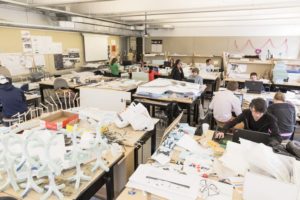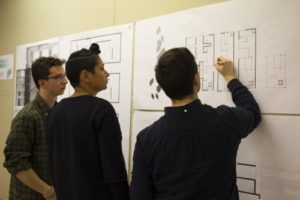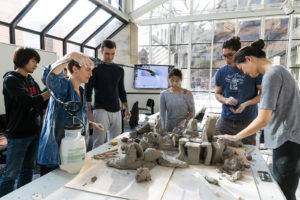

01. A Strange Thing Called the “Studio”…
In 2009, I came to the United States to study architecture. On the first day of school, I, together with all the other freshmen, found ourselves in a spacious room, where each of us got to claim a rather generously sized work desk. You might laugh, but my biggest “learning moment” on that day was to discover that this very large room, in fact, shared the same name with a course in the architecture program – the “studio”. For me, who only spoke English as a second language, the connection between a space and a course was just too linguistically intriguing.
As it turned out, the studio course was nothing like any classes I had taken in my life, and it probably did make sense to name the course after the room. While my friends in other majors ran around the campus to attend lectures, research on assignments, and write exam papers, we architecture kids spent most of the time on our work desks, sketching design ideas and making models as part of the studio education.
At that time, it was rather fascinating for me to find out, and gradually get used to the fact, that the studio instructors seldom prepared lecture slides or tested our knowledge using papers or exams; they taught the studio course by coming to each student’s desk, discussing the students’ design ideas face-to-face, and pointing out their merits, deficiencies, and directions for improvements.
This particular way in which studio courses are handled in architecture schools, in fact, resembles a very traditional form of teaching – the good old apprenticeship system.
In the past, when knowledge and techniques were not codified, the masters passed on specific trades and crafts to the next generation by training apprentices. Because much of the masters’ knowledge was tacit, not explainable just by words, they could only “teach” it by actually doing the task themselves, and the apprentices essentially learned the crafts by closely observing and imitating the masters’ actions. The modern-day architectural education, which is centered around the design studio, is very much like an apprenticeship. Through hands-on design work and face-to-face communication, the studio instructors provide architecture students with a set of tacit knowledge that does not exist in any books.
But this is not why architectural education fails.

02. Rule by Experience
All apprenticeship-ship based education systems put great emphasis on experience. By experience, I mean the opposite of abstract theory, codified knowledge, or universal principles of truth – these properties, which are so prevalent in disciplines such as physics and mathematics, do not really exist in architectural design. Because the design field is practice-based, the development of any design resolution, as well as its judgment and critique, is often contingent on specific situations and contexts.
In architecture, if someone has years of experience in the field and knows how to link specific design techniques to their desired ends, that person will be deemed qualified to teach students how to design. Although they may not be able to explain exactly why one design proposal is better than the other, their intellectual authority will still be upheld because of their experience.
The design instructor in the architecture school is very much like the old village man who leads and ensures the functionality of traditional agricultural communities. The old man often looks at the shapes of the cloud and knows whether the peasants should go to the crop field. He understands no meteorology or biology, but he is just right, because of his years of experience. For young peasants in the village, they must obey the old man because there exist no other sources of knowledge. No questions, explanations, or validations are ever needed for the old man’s words. This exemplifies how, in many traditional or practice-based fields, including architectural design, one must always worship the experienced.
When I was still in college, I used to think that the biggest difference between my major – architecture and other disciplines was the hands-on nature of design education. Only after I graduated did I realize that I had been wrong. The truly unique feature of architectural education is the absolute power we put in the hands of studio instructors – the masters who are obeyed and worshipped because of their experiences.
But why? Why do architecture students have to worship and learn from those who have the most experience? This is because, essentially, studio instructors in architecture school play a very different role than teachers and professors in other disciplines.
In the economics department for example, theoretically speaking (no pun intended), the students can learn most of the existing knowledge, if not all, via self-study, reading books and cracking practice tests. Most of the knowledge already exists in codified form, and the role of the instructors in economics is simply to facilitate the students to learn better and faster. (Of course, I am not talking about research-related activities here.)
In architecture school, we do things rather differently. Usually and especially during the formative period of professional training (the first three years of the undergraduate degree program or the first two years of the graduate program), students simply cannot learn design without an instructor. This is because all the judgment, appreciation, intuition, and understanding of the techniques and effects of design come, and can only come, from the studio instructors’ face-to-face feedback and personal demonstration. Because design is practice-based, contingent on specific situations, and can seldom be evaluated against abstract, universal principles, the studio instructors often, if not always, dominate the students and hold absolute intellectual authority because of their experiences. After all, no books or codified knowledge exist that students can use to learn design and challenge their instructors.
Essentially, in architecture school, the masters do not pass on knowledge. They are the embodiments of knowledge themselves.
But again, this is not why architectural education fails. But we are beginning to see some hints.

03. The Sudden Intellectualization of Architecture
At some point in recent history, architectural education began to change.
Nowadays, what architecture students hate the most is to be misunderstood as “someone who simply study the nuts and bolts of making buildings”.
In our eyes, we are much more complex, sophisticated, and intellectually ambitious than a building designer. We are in a highly interdisciplinary field, where arts, humanities, science, and technology all beautifully converge and make us the most interesting people on campus.
This attitude marks a larger, though seemingly subtle, discipline-wide reorientation process, which I shall call the “intellectualization of architecture”. I will explain this process below and illustrate with my own personal experience.
After college, I went on to pursue a graduate degree in architecture. In my school, the dean once made the following statement:
“Indeed, we aspire to be the world’s intellectual leader on the future of the city.”
Evidently, everyone in the school, from students to professors to the dean, was unsatisfied with, and outraged by, the assumption that architecture is only practice-oriented and that our field is not committed to higher, more intellectual pursuits. In fact, across the United States, schools have for quite some time been rebelling against the traditional, building-focused mode of architectural education and discourse. Think about how pathetically unpopular a studio course would be if it did not address some political, technological, or philosophical dimensions of contemporary society. After all, what can be more boring, lethargic, and ultimately uninspiring than a school curriculum that only instructs the students to design a roof structure or façade treatment?
Hence the intellectualization of architecture. Starting from school curricula, and now gradually to offices and client presentations, architects are searching for the kind of abstract knowledge, as well as a whole new set of language and discourse, that did not exist in the old era of masters and apprentices. By pursuing new knowledge and becoming intellectually sophiscated, students, professors, and practitioners begin to defend and redefine the integrity of architecture.
This new direction, as I will argue, has unintentionally led to the failure of architectural education.

04. The Great Paradox
For those who have been in architecture school, have you ever wondered why studio reviews are always so insanely absurd?
By absurd, I mean the awkward and often quite laughable situation where the students, the instructors, and the critics always turn out to be talking about completely different and unrelated things during the review. For example, when one person raised Subject A, another person would touch her chin and say: “Well, have you considered Subject B?” Then, the third person, in the fear that she had not appeared smart enough, would put Subject C on the table, which was tangential at best to what was discussed by the group.
I used to think that the absurdity of what I just described was about sadness – the sadness felt by the students when no one in the review really addressed the work pinned up on the wall. But as I thought of it more carefully, I began to realize that the true absurdity of studio reviews stemmed from the fact that, during such reviews, there were just opinions without debates.
Opinions are those who worship the experienced like to use to defend and elevate themselves. Debates, which work in a very different way, disect arguments with logic and are the building blocks of knowledge and intellectual pursuits. Studio reviews in architecture school are often saturated with smart-sounding opinions on a wide range of subjects, but if you listen carefully and search for traces of actual debates, you will hear nothing.
In architecture school nowadays, while the curricula are remodeled to include more “knowledge-rich” contents than the past model, which was centered around building-making practices, the students and the teachers, however, still habitually talk to each other based on the same old rule of experience-ism. Classrooms and studios are bombarded by phrases such as “I think …” and “I believe”, and libraries and reading rooms are filled with manifestos. Yet in the end, no one is using rigorous and scholarly methods to explore, debate, and investigate their subjects.
In this way, the intellectualization of architecture is devoid of scholarization. I may have made up the word here, but by scholarization, I mean the way in which one pursues knowledge and understands the relationship between things using rigorous academic methods. As far as I know, no academic discipline can truly advance itself without its constituents adopting such scholarly methods.
In traditional, apprenticeship-based disciplines, those who have more experiences will automatically “make more sense”. In academic fields concerned with the pursuit of knowledge, the truth shall be defined based on scholarly debates and research. No one should dominate others intellectually simply because they have been around for a longer time. Whether or not a theory makes sense should have no causal relations with the length of its proposer’s CV.
In many architecture schools across the United States, studio instructors are not trained in scholarly research methods; some are not interested in academia at all – they teach studio courses as an extension of their professional practices, they excel in the apprenticeship system (as trainees years ago, and as trainers now), and their intellectual authority comes from their years of experience practicing in the design field. After all, you do not, and people think you should not, pursue a Ph.D. degree in order to teach design studio.
But for architecture today, teaching cannot be based on the rule of experience anymore, not if the goal of the discipline is to intellectualize itself and embark its pursuit for advanced knowledge. If students and teachers of architecture hope to establish a serious system of knowledge generation, they need to be interested in, and be rigorously adopting, the scholarly methods of debates, research, and pursuit of truth.
Admittedly, it is perfectly fine for studio instructors to formulate seeds of knowledge based on their personal practices and tastes – after all, even the most abstract theories do come from experiences in the real world. However, it will be deeply problematic if these instructors are teaching their new theories to the students based on the master-apprentice model, instead of working together with the class to explore the vastness and the limits of new knowledge based on scholarly research and debates. Pursuing new knowledge without rigorous scholarly methods is like driving a train without staying on its track – the derailed train can still move forward for a period of time, but the more the driver tries to hit the gas, the more harm she will eventually cause to the passengers.
Architecture schools nowadays pursue intellectualization as their new goal, but they still, for most of the time, adopt the experience-based teaching method in studios. The paradox between these two is why architectural education fails.

05. What Can We Do?
I pose this question, but I am not ready to answer it. Nonetheless, based on the analysis above, I will write down three further implications:
Reflecting my seven-year career as an architecture student, I find myself extremely fortunate to have met a number of colleagues and mentors who passionately and rigorously pursue new knowledge. Some of them are outcasts in their environments; others are recognized as leaders in their fields. Let us believe that to see and understand the absurdity in such reality is the first step of revolt.
(Picture credits: Syracuse University School of Architecture, Harvard University Graduate School of Design)